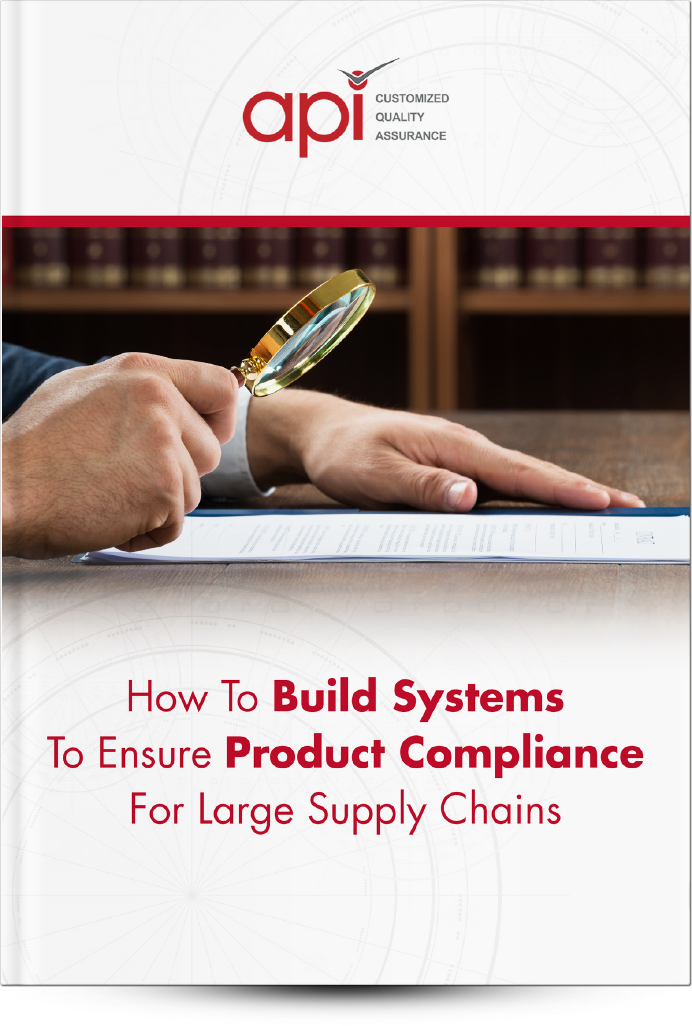Procurement used to manage vendors and negotiate costs. In today’s global sourcing landscape, it’s about so much more; it’s about effectively managing risk, ensuring sustainability, all to the ends of creating a strategic competitive advantage for your brand.
The key to this progression?
Technology.
Technology has been a lead disruptor in many industries. It has enabled a more visible supply chains calling for more effective ways of managing areas of risk and sustainability.
Advancement in this industry comes with its own unique set of challenges, ones that can only be met with innovative strategies, preparation and the adoption of technology to enhance your capabilities.
As we move into 2018, we move into a new year with new possibilities and new heights to be achieved. But before then, what does the state of retail look like today?
The Current State Of Retail
Over the last couple of years we have seen the shift towards omnichannel retailing, where there is a demand for product to get to the end-user faster than ever before.
Amazon has been leading the charge in this area with their online purchasing systems and same day delivery options. This increase in pace has lead to an increase in pressure on retail supply chains, and that is of course not without its own challenges.
The state of retail research report states that the top three experienced retail supply chain challenges for 2017 are: handling promotions, better collaboration with suppliers and availability without increasing stockholding.
This can be achieved through the automation of your demand forecasting and accurate centralised data tracking will be key as you look to overcoming this year’s challenges.
Successfully addressing your current challenges, lays the foundation for a competitive position in the marketplace with systems already in place to handle the challenges that the new year has to offer.
The future of global sourcing holds as many opportunities as it does new, more complex challenges, a few of which we will take a look at it below.
What global sourcing and procurement challenges can your hardlines retail supply chain expect to face in the future?

I list but five of the predicted challenges to arise over the next 10 years:
- Risk – Over the next 10 years we will see a shift in the way that risk is approached. Currently the risk management approach taken by most quality and procurement professionals has to do mainly with product and regulation compliance. It is predicted that a more holistic approach to handling risk will be adopted.This is predicted to be accomplished through defining new metrics and data points for a fuller, more defined picture, enabling the ability to plan and address risk in a way that has not successfully been accomplished before.
- Sustainability – The cost of sustainable supply chains has always been a primary factor for not adopting sustainable approaches to business. The future sees that the role of procurement will move beyond that, and look to creating and sustaining social value. This point cannot go without mention that within the next 10 years we will see the largest sector of our workforce being filled with millenials, who care about sustainable and economic growth. It is predicted that there will be less exploitation of resources with a stronger use and reuse cyclical economy.
- Collaboration – Collaborative outsourcing will be key to managing the array of everyday supply chain complexities. This will be based on mutual interest and trust leading to a mutually beneficial outcome. In 10 years time, the complexities you are currently experiencing will need to increase as you endeavour to manage multiple vendors at one time. If you are collaborating and building successful relationships with your suppliers, then this will be an easier transition for you.
- Transparency – Much of the supply chain has nothing to do with the end-user of your product, but with the dawn of social media your role as a quality or procurement professional may need to. The era of social media has brought about transparency like no other, increasing the spotlight on retail brands and their supply chain operations. You will need to ensure that your entire supply chain adopts a “social” mindset which will create a business model that has the brands image at the fore.
- Information – We are in the age of big data, the success of your supply chain relies on it. You will need to embrace big data through advanced data mining and analysis. We are increasingly finding ourselves in a world driven by data, and this will only increase over time with more access to real-time data tracking and updates. The key is to begin planning for this. Start asking yourself what your data capacity currently is, look at your own data and begin mapping how you will embrace the coming of a bigger data age.
So, how will these challenges impact you?
So while you are still in the process of building systems to deal with your 2017 challenges as you move into a busy 2018 season, the quality systems you put in place today will form the foundation, the very building blocks of how you are to manage the above mentioned challenges as we journey towards to the future.
Think of it as a road map allowing you to effectively plan for the future.
The above global sourcing challenges increase your level of supply chain transparency, a holistic approach to managing your risk, but each one of these challenges requires technology to optimise the current and predicted supply chain pace.
The adoption of new technology will mean that more data will be available for analysis, allowing a lot more insight, visibility and transparency into your operations. The more data you have the more effectively you can produce products of the highest quality, and the better you can identify risk early on.
Key Takeaways
After delving into some of the top challenges that retailers came up against in 2017 and as you seek to efficiently plan for 2018, the key will be to improve your current operating systems through clever, more advanced technologies and strategic planning.
So let’s look at some ways that you can begin this process;
- Automate your forecasting processes – There are technologies and systems that you can adopt to ease this process for your brand. You can use the well reviewed SAS demand forecasting software to help you solve your forecasting troubles; “the combined power of automation, analytics and workflow, you can generate the most unbiased and accurate large-scale demand forecasts.” Resistance to this will only set you back, as your competitors will be doing everything to embrace growth. In adopting technology to automate your forecasting process you will be saving yourself time, a resource that can be used elsewhere.

- Data tracking – For store stock levels, online stocks, current distribution centre stocks, predicted future stock levels in distribution centres, finished goods in transit, inventory being shipped from freight forwarders etc. Accuracy in this regard is key and technology can provide that, and do away with human controlled data entries.
-
- Supplier collaboration – Fostering a culture of supplier collaboration will have long term benefits for your brand. While we have all sorts of technology that can be used to aid communication with your supplier, it is often the tried and tested face to face experience that truly allows for an effective and mutually beneficial relationship that is collaborative in nature.
Adopting new technologies and strategies, while you may be resistant at first, will only be if benefit to the optimisation of your supply chain operations, resulting in bottom line benefits for your brand.
Facing supply chain challenges head on is not easy, but it will require your leadership to embrace the challenge that lies ahead and grasp the opportunity for learning, in order to create a well run and competitive supply chain for your brand.
Let us know in the comments section if you are currently facing these challenges and what you have done to address them?
 Effectively managing growing supply chain complexities is something that most purchasing managers/importers deal with on a day to day basis.
As your brand grows compliance issues you never knew were there (nor were prepared for) may rear their ugly head, and it’s up to you to begin pinpointing issues and plugging the holes your profits will fall through, before the consumers of today tear them open even wider.
Ensuring product compliance starts and ends with one thing:
A robust compliance program.
Effectively managing growing supply chain complexities is something that most purchasing managers/importers deal with on a day to day basis.
As your brand grows compliance issues you never knew were there (nor were prepared for) may rear their ugly head, and it’s up to you to begin pinpointing issues and plugging the holes your profits will fall through, before the consumers of today tear them open even wider.
Ensuring product compliance starts and ends with one thing:
A robust compliance program.
 Effectively managing growing supply chain complexities is something that most purchasing managers/importers deal with on a day to day basis.
As your brand grows compliance issues you never knew were there (nor were prepared for) may rear their ugly head, and it’s up to you to begin pinpointing issues and plugging the holes your profits will fall through, before the consumers of today tear them open even wider.
Ensuring product compliance starts and ends with one thing:
A robust compliance program.
Effectively managing growing supply chain complexities is something that most purchasing managers/importers deal with on a day to day basis.
As your brand grows compliance issues you never knew were there (nor were prepared for) may rear their ugly head, and it’s up to you to begin pinpointing issues and plugging the holes your profits will fall through, before the consumers of today tear them open even wider.
Ensuring product compliance starts and ends with one thing:
A robust compliance program.


 with efficient quality procedures. They are also up to date with the latest developments in the industry along with the best practices to follow. As a result, you have all the expertise and
with efficient quality procedures. They are also up to date with the latest developments in the industry along with the best practices to follow. As a result, you have all the expertise and 
 2. Strategic partnerships
2. Strategic partnerships 3. Inventory management tactics
Managing inventory is all about balance. Making sure that you don’t have too much inventory thus face the risk of increased storage costs and a longer time to market having an effect on your return. You also need to make sure you don’t have too little inventory forcing people to shop elsewhere for a similar product. Both sides of the equation can have detrimental effects for your brand. Here we look at two inventory management tactics that are applied by two of the biggest global retailers:
3. Inventory management tactics
Managing inventory is all about balance. Making sure that you don’t have too much inventory thus face the risk of increased storage costs and a longer time to market having an effect on your return. You also need to make sure you don’t have too little inventory forcing people to shop elsewhere for a similar product. Both sides of the equation can have detrimental effects for your brand. Here we look at two inventory management tactics that are applied by two of the biggest global retailers:
 4. Quality Control
4. Quality Control they need products. You may find yourself at a loss with a delivery delay. Contingency plans are essential to ensuring your product gets to market. A
they need products. You may find yourself at a loss with a delivery delay. Contingency plans are essential to ensuring your product gets to market. A  1.Risk Management – Global brands take every procedure into account when understanding possible areas of risk. From sourcing to logistics to inventory management, each of these areas affects one another. If there is a problem with sourcing, it inadvertently affects the logistics of the entire operation. Therefore a brand such as Amazon needs to have a Risk Mitigation strategy that spans the entire operation.
1.Risk Management – Global brands take every procedure into account when understanding possible areas of risk. From sourcing to logistics to inventory management, each of these areas affects one another. If there is a problem with sourcing, it inadvertently affects the logistics of the entire operation. Therefore a brand such as Amazon needs to have a Risk Mitigation strategy that spans the entire operation.
 should be used. Automating this processes allows for transparency and an up to date inventory procedure.
should be used. Automating this processes allows for transparency and an up to date inventory procedure.
 Miller is seen as instrumental in paving the way with greening the supply chain from using a green design for their products, to ensuring they use less harmful chemicals within the products. The only way they were able to do this was through gaining supplier buy-in. They asked their suppliers to begin complying with the zero-waste policies within their procedures.
Miller is seen as instrumental in paving the way with greening the supply chain from using a green design for their products, to ensuring they use less harmful chemicals within the products. The only way they were able to do this was through gaining supplier buy-in. They asked their suppliers to begin complying with the zero-waste policies within their procedures.
 effectively manage their supply chains. Regionally there is the thought that this may be too expensive to apply. When it comes to technology, it is too easy to jump to the first software you find. It is essential to understand what you need technology to do for you, so that you may select the type of technology that is best suited to your needs. By doing this, you are ensuring that this is not overly costly for you and maximizes its efficiency for you.
effectively manage their supply chains. Regionally there is the thought that this may be too expensive to apply. When it comes to technology, it is too easy to jump to the first software you find. It is essential to understand what you need technology to do for you, so that you may select the type of technology that is best suited to your needs. By doing this, you are ensuring that this is not overly costly for you and maximizes its efficiency for you.
 If we take a look at Targets mistake of launching the toddler sized Barbie SUV country-wide, the problem they faced was that their distribution centers were receiving inventory faster than they were distributing it to stores across the country. This meant that there were Target stores that had empty shelves with none of the promised items in store. They attributed this to inconsistencies between actual inventory and the computer records. A mistake like this will have cost millions in revenue loss, but also detrimental to both Target and Barbie. As a supply chain manager, it is up to you to ensure you suppliers and distribution centers operate on the same system to mitigate risks like this occurring.
If we take a look at Targets mistake of launching the toddler sized Barbie SUV country-wide, the problem they faced was that their distribution centers were receiving inventory faster than they were distributing it to stores across the country. This meant that there were Target stores that had empty shelves with none of the promised items in store. They attributed this to inconsistencies between actual inventory and the computer records. A mistake like this will have cost millions in revenue loss, but also detrimental to both Target and Barbie. As a supply chain manager, it is up to you to ensure you suppliers and distribution centers operate on the same system to mitigate risks like this occurring.
 A team that is led by someone who has a strong sense of leadership can drive the team towards the finish line in a successful manner and ensure that they are achieving the supply chain goals. A strong leader needs to be able to ensure that everyone is on track to achieving the goals as set out. They need to build confidence within the team.
The leader is also responsible for managing all relationships and removing any issues that may hinder the effective functioning of the team. Lastly, the team needs to see you in the trenches, alongside them, digging deep. This creates a sense of solidarity and unity with your team.
“Which business leaders do you look up to? Let me know in the comments below…”
A team that is led by someone who has a strong sense of leadership can drive the team towards the finish line in a successful manner and ensure that they are achieving the supply chain goals. A strong leader needs to be able to ensure that everyone is on track to achieving the goals as set out. They need to build confidence within the team.
The leader is also responsible for managing all relationships and removing any issues that may hinder the effective functioning of the team. Lastly, the team needs to see you in the trenches, alongside them, digging deep. This creates a sense of solidarity and unity with your team.
“Which business leaders do you look up to? Let me know in the comments below…”
 Regular, daily reports are important for tracking team progress. The data collected and presented in your weekly meetings should align with your quality control plan and should make recommendations and adjustments where necessary. This will help you and your team understand what goals are on track to being achieved, what problems may need to be addressed and what things need a more strategic focus.
The more accurate and concise your reporting is, the more focused your quality team can be in fixing potential problems and even avoiding potential risks. If your supply chain key performance indicators are not aligned with all departments of your
Regular, daily reports are important for tracking team progress. The data collected and presented in your weekly meetings should align with your quality control plan and should make recommendations and adjustments where necessary. This will help you and your team understand what goals are on track to being achieved, what problems may need to be addressed and what things need a more strategic focus.
The more accurate and concise your reporting is, the more focused your quality team can be in fixing potential problems and even avoiding potential risks. If your supply chain key performance indicators are not aligned with all departments of your  Creating a sense of trust and motivation within your team may sound too emotive for you, but everyone has a desire to be motivated. This creates a sense of ownership and a deeper sense of responsibility and control over their work.
Improved team trust leads to an energized team, an energized team can lead to procedural innovation within your
Creating a sense of trust and motivation within your team may sound too emotive for you, but everyone has a desire to be motivated. This creates a sense of ownership and a deeper sense of responsibility and control over their work.
Improved team trust leads to an energized team, an energized team can lead to procedural innovation within your  There is evidence that supply chains are often managed functionally with metrics, systems, and behaviors geared to managing the performance of a specific area. Whilst detailed functional knowledge and understanding are essential to delivering a quality product, a narrow view can lead to a potential misalignment of the different elements of the chain towards the end goal. Senior management needs to ensure that decisions which are taken at the top are not sub-optimised in the operational execution. In practical terms, this means a real transformation in how measurement systems are designed and implemented to ensure that there is a full understanding of how the business interlinks. Individual incentives and success need to be aligned for the achievement of overarching goals, not purely functional excellence.
There is evidence that supply chains are often managed functionally with metrics, systems, and behaviors geared to managing the performance of a specific area. Whilst detailed functional knowledge and understanding are essential to delivering a quality product, a narrow view can lead to a potential misalignment of the different elements of the chain towards the end goal. Senior management needs to ensure that decisions which are taken at the top are not sub-optimised in the operational execution. In practical terms, this means a real transformation in how measurement systems are designed and implemented to ensure that there is a full understanding of how the business interlinks. Individual incentives and success need to be aligned for the achievement of overarching goals, not purely functional excellence.
 Be clear – This may sound like an obvious basic principle, but it’s vital to make sure the ‘narrative’ of the information comes across so that it is understood easier and its relevance and context are clear. Use a brief headline, to sum up, the information being communicated and focus on the key aspects of the data as well as why it is important and how it can be used.
Be clear – This may sound like an obvious basic principle, but it’s vital to make sure the ‘narrative’ of the information comes across so that it is understood easier and its relevance and context are clear. Use a brief headline, to sum up, the information being communicated and focus on the key aspects of the data as well as why it is important and how it can be used. Retailers can protect themselves from potential supply chain interruptions or delays associated with suppliers’ human rights, labor, environmental, and governance practices by ensuring buying offices have effective compliance programs and robust management systems. Here are steps to manage risk:
Retailers can protect themselves from potential supply chain interruptions or delays associated with suppliers’ human rights, labor, environmental, and governance practices by ensuring buying offices have effective compliance programs and robust management systems. Here are steps to manage risk:
 Inaccurate data, existing systems infrastructure, and entrenched business practices are common barriers to the implementation of quality management systems. The importance of getting existing processes in line with
Inaccurate data, existing systems infrastructure, and entrenched business practices are common barriers to the implementation of quality management systems. The importance of getting existing processes in line with 


